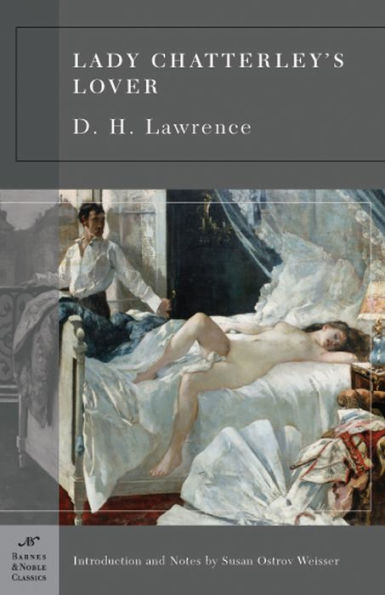Read an Excerpt
From Susan Ostrov Weisser’s Introduction to Lady Chatterley’s Lover
To some in the reading public, D. H. Lawrence was notorious as a vulgar pornographer; to others, he was an apostle of sexual liberation. It is interesting and ironic to note, therefore, that the early working title of Lady Chatterley’s Lover was “Tenderness.” Lawrence was indignant and disgusted by the public misunderstanding of his intentions, for he loathed casual sex or promiscuity, but he was also not an advocate of what he called “modern” romantic love. “Love is chiefly bunk,” he wrote in 1925 to his friend “Brett,” the Honorable Dorothy Brett, “an over-exaggeration of the spiritual and individualistic and analytic side. . . . If ever you can marry a man feeling kindly towards him, and knowing he feels kindly to you, do it, and throw love after.” Certainly the tentative title suggests that Lawrence meant this, his last novel, to be a story of real tenderness, but he intended to write about a different sort of love affair than can be found in the history of the British novel. Unlike the European novel, which is rich in tales of adultery (as in The Red and the Black, Madame Bovary, and Anna Karenina), romantic love in the nineteenth-century British novel tends either to lead to marriage or is destroyed because of illegitimate sexual activity. But in Lawrence’s last novel something new is going on, a new look at the cultural values by which we live: Lawrence’s characters are healed by their forbidden sexual love, rather than destroyed by it.
The famous love affair between Lady Chatterley and her gamekeeper was provocative also because it crossed class lines; it skipped over the middle class and united aristocracy and working class in an intimacy meant to threaten traditional sanctified hierarchies. This sexual union became so famous that the lady and the gamekeeper have become a kind of joke or cliché in modern literary culture. But in fact Lawrence drew on a tradition in the English novel of love and sex across class lines: Fielding, Dickens, Brontë, Eliot, and Hardy, to name a few, wrote about lower-class men and women hoping to marry “above” them and sometimes succeeding, or otherwise explored the trouble that class differences cause in love. More often the male lover has the class status, as in Samuel Richardson’s Pamela or Charlotte Brontë’s Jane Eyre; frequently this common plot involves the pathos of seduction and the vulnerability of the heroine to male abandonment. The heroines Little Em’ly of Charles Dickens’s David Copperfield, Hetty in George Eliot’s Adam Bede, or Tess in Thomas Hardy’s Tess of the D’Urbervilles represent innocent victims of male sexual exploitation, whereas another innovation of Lawrence’s is that the forbidden sexual relationship between his lovers is based on mutual desire.
Lawrence was widely read in European literature and well aware of this history of the British novel, in which sexuality and romantic love served the purposes of moral discourse. In Lady Chatterley’s Lover in particular, he wanted to do something pointedly different. For better or worse, his treatment of the fictional theme of transgressive love and sex thus became fraught with the burden of a new meaning he wanted to place on it, a kind of morality free of tradition and conventional religious prohibitions. But this rebellion is not simply one of individual freedom; Lawrence embedded in Lady Chatterley’s Lover the meanings of sexual love and class conflict in a kind of war against our “civilization” as he had come to understand it. For Lawrence, the novel was a kind of weapon against a peculiarly modern development: He saw the social alienation from our bodies and the pleasures of the senses as the direct result of a soulless industrialism, the spirit of possessiveness and commercialism.
It is not coincidence that the interlinked themes of industrialism, class identity, and division on the one hand, and adulterous love on the other, were also important in Lawrence’s own life. In his partly autobiographical essay, “Nottingham and the Mining Countryside,” Lawrence portrays the area in which he was born and raised as marked by a curious division. He described Eastwood, a mining village near Nottingham, in contrasting terms, “a curious cross between industrialism and the old agricultural England”: “It was still the old England of the forest and agricultural past. . . . The mines were, in a sense, an accident in the landscape, and Robin Hood and his merry men were not very far away” (Phoenix, pp. 133, 135; see “For Further Reading”).
For Lawrence, town and country, industry and nature, old and new, were startlingly close by one another and yet also hopelessly separated. Lawrence felt this conflict deeply. On his father’s side, Lawrence was connected to the mining industry that dominated the town for generations. His grandfather had been company tailor for the local mine, and Arthur Lawrence, his father, was a collier (miner), though he rose to the position of “butty,” a kind of manager of a group of miners, a slightly better-paying job. As readers of Lawrence’s autobiographical novel Sons and Lovers know, Lawrence’s father married a woman, Lydia Beardsall, who considered herself above his class, a conflict that became a seminal fact in Lawrence’s upbringing. Lydia Beardsall’s family had once made (and lost) money in the Nottingham lace industry, and in her own view she was far more cultivated, religious, and shrewd—“superior” (that is, possessing the manners, accent, and culture of the middle class). Bitterly disappointed in her choice of husband and the life he could give her, she turned her full attention to her children and her ambitions for them.









